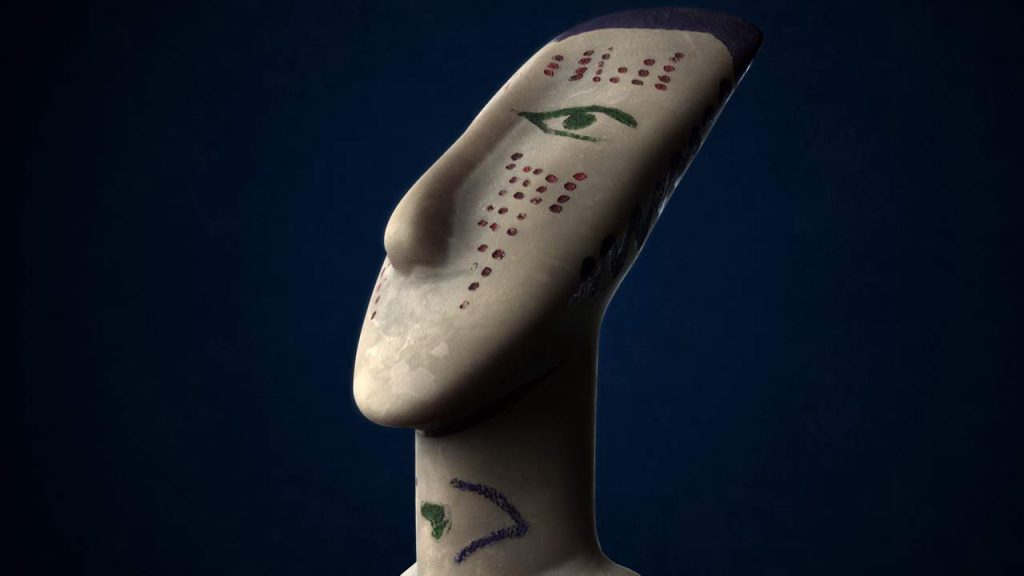Buried Secrets of Keros: An investigative journey set in the heart of the Aegean Sea. A team of archaeologists unveil what may be the world’s oldest maritime sanctuary. Keros, a small uninhabited island of the southeastern Cyclades, attracted the archaeological attention for the first time at 1884 when a tomb containing marble figurines was found. Since then, the extended illegal excavations during the ‘50s and ‘60s on the western part of the island at Cavos site, had as result the illegal export of a large number of marble artifacts.
Some scholars thought that the Cavos site had religious character and C. Renfrew supposed that it must have been a great and open air pan-cycladic sanctuary of the Early Cycladic period (3rd millennium BC), where a ritual of destruction of objects took place !
During the last years, a discussion on the so-called “treasure of Keros” began as the excavations restarted on the island conducted by a greek-british archaeological team under the supervision of Professor Colin Renfrew. Professor Lord Colin Renfrew is Senior Fellow of the MacDonald Institute for Archaeological Research of the University of Cambridge and excavator of Keros on behalf of the British Schooll at Athens.
Buried Secrets of Keros
In collaboration with a team of experts and using state-of-the-art technology, archaeologist Dr. Kostas Paschalides (PhD Prehistoric Archaeology, Curator of the Collection of Prehistoric, Egyptian, Cypriot and Eastern Antiquities of the Archaeological Museum of Athens), guides us through the unique exploration of the island of Keros, where hundreds of broken Cycladic figurines where found and have been the subject of long-lasting scientific study.
Seeking to unveil more, Dr. Costas Paschalides will meet Professor Colin Renfrew and Dr. Michael Boyd, co-directors of the Keros Project the University of Cambridge, who lead the multi-year excavation on the island of Keros. Professor Colin Renfrew, one of the world’s leading archaeologists, National Geographic Explorer and member of the National Geographic Society, a member of the British Academy and the House of Lords of the United Kingdom, is one of the first archaeologists to have landed on Keros in 1963.
Dr. Michael Boyd, is a Senior Research Associate at the McDonald Institute for Archaeological Research at the University of Cambridge. His main research interests lie in the prehistoric Aegean where he has worked in the Peloponnese and Cyclades. He is also co-editor of the Keros publications series with Colin Renfrew. Researchers of the Cyprus Institute also participate in the excavations, among them the Institute’s Assistant Professor in Archaeobotany and assistant director of the Cambridge Keros Project, Dr. Evi Margaritis, whose study of ancient seeds reveals details about the day-to-day activities of the Keros inhabitants.
Keros
Keros is an uninhabited Greek island in the Cyclades about 10 km (6 mi) southeast of Naxos. Administratively it is part of the community of Koufonisia. It has an area of 15 km2 (6 sq mi) and its highest point is 432 m (1,417 ft). It was an important site to the Cycladic civilization that flourished around 2500 BC. Now is forbidden to land in Keros.
Keros is especially noted for the flat-faced Cycladic marble statues which later inspired the work of Pablo Picasso and Henry Moore. The “Keros Hoard” is a very large deposit of Cycladic figurines that was found on the island of Keros.
In 2006-2008, the Cambridge Keros Project, co-directed by Colin Renfrew with others, conducted excavations at Kavos on the west coast of the island. This general area is believed to be the source of the so-called “Keros Hoard” of fragmentary Cycladic figurines. The material excavated in 2006-2008 includes Cycladic figurines, vessels and other objects made of marble, all broken prior to deposition and most likely broken elsewhere and brought to Kavos for deposition. The lack of joining fragments shows that only a part of the broken material was deposited here, while ongoing studies of the pottery and other material show that material was brought from multiple sources for deposition here.




